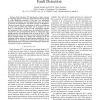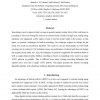ICCAD
1998
IEEE
14 years 10 months ago
1998
IEEE
This paper presents a novel concurrent fault simulator (called CONCERT) for nonlinear analog circuits. Three primary techniques in CONCERT, including fault ordering, state predict...
ATS
1998
IEEE
14 years 10 months ago
1998
IEEE
This paper presents a new effective Built-In Self Test (BIST) scheme that achieves 100% fault coverage with low area overhead, and without any modification of the circuit under tes...
DAC
2000
ACM
14 years 10 months ago
2000
ACM
Real defects (e.g. stuck-at or bridging faults) in the VLSI circuits cause intermediate voltages and can not be modeled as ideal shorts. In this paper we first show that the trad...
ATS
2000
IEEE
14 years 10 months ago
2000
IEEE
: In this paper a complete analysis of spot defects in industrial SRAMs will be presented. All possible defects are simulated, and the resulting electrical faults are transformed i...
VTS
2002
IEEE
14 years 11 months ago
2002
IEEE
The ever increasing trend to reduce DPM levels of memories requires tests with very high fault coverages. The very important class of dynamic fault, therefore cannot be ignored an...
DATE
2002
IEEE
14 years 11 months ago
2002
IEEE
Models meant for logic verification and simulation are often used for ATPG. For custom digital circuits, these models contain many tristate devices, which leads to lower fault co...
DATE
2010
IEEE
14 years 11 months ago
2010
IEEE
—Fault tolerance (FT) has become a major concern in computing systems. Instruction duplication has been proposed to verify application execution at run time. Two techniques, inst...
VTS
2003
IEEE
14 years 11 months ago
2003
IEEE
Reseeding is used to improve fault coverage of pseudorandom testing. The seed corresponds to the initial state of the LFSR before filling the scan chain. The number of determinist...
VTS
2003
IEEE
14 years 11 months ago
2003
IEEE
Reseeding is used to improve fault coverage in pseudo-random testing. Most of the work done on reseeding is based on storing the seeds in an external tester. Besides its high cost...
MTDT
2003
IEEE
14 years 11 months ago
2003
IEEE
: Linked faults are very important for memory testing because they reduce the fault coverage of the tests. Their analysis has proven to be a source for new memory tests, characteri...


